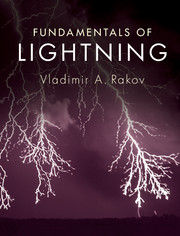Book contents
- Frontmatter
- Dedication
- Contents
- Preface
- 1 Types of lightning discharges and lightning terminology
- 2 Incidence of lightning to areas and structures
- 3 Electrical structure of thunderclouds
- 4 Properties of the downward negative lightning discharge to ground
- 5 Calculation of lightning electromagnetic fields
- 6 Modeling of the lightning return stroke
- 7 Measurement of lightning electric and magnetic fields
- 8 Electromagnetic methods of lightning location
- 9 Lightning damaging effects and protective techniques
- Appendices
- References
- Index
3 - Electrical structure of thunderclouds
Published online by Cambridge University Press: 05 April 2016
- Frontmatter
- Dedication
- Contents
- Preface
- 1 Types of lightning discharges and lightning terminology
- 2 Incidence of lightning to areas and structures
- 3 Electrical structure of thunderclouds
- 4 Properties of the downward negative lightning discharge to ground
- 5 Calculation of lightning electromagnetic fields
- 6 Modeling of the lightning return stroke
- 7 Measurement of lightning electric and magnetic fields
- 8 Electromagnetic methods of lightning location
- 9 Lightning damaging effects and protective techniques
- Appendices
- References
- Index
Summary
General information about thunderstorms
The primary source of lightning is the cloud type termed “cumulonimbus,” commonly referred to as the “thundercloud.” Lightning-like electrical discharges can also be generated in the ejected material above volcanoes, in sandstorms, and in nuclear explosions.
Before reviewing the electrical structure of thunderclouds it is worth outlining their meteorological characteristics. In effect, thunderclouds are large atmospheric heat engines with the input energy coming from the Sun and with water vapor as the primary heat-transfer agent (Moore and Vonnegut, 1977). The principal outputs of such an engine include (but are not limited to) (1) the mechanical work of the vertical and horizontal winds produced by the storm, (2) an outflow of condensate in the form of rain and hail from the bottom of the cloud and of small ice crystals from the top of the cloud, and (3) electrical discharges inside, below, and above the cloud, including corona, lightning, sprites, halos, elves, blue starters, blue jets, and gigantic jets. The processes that operate in a thundercloud to produce these actions are many and complex, most of them being poorly understood. A thundercloud develops from a small, fair-weather cloud called a “cumulus,” which is formed when parcels of warm, moist air rise and cool by adiabatic expansion; that is, without the transfer of heat or mass across the boundaries of the air parcels. When the relative humidity in the rising and cooling parcel exceeds saturation, moisture condenses on airborne particulate matter to form the many small water particles that constitute the visible cloud. The height of the condensation level, which determines the height of the visible cloud base, increases with decreasing relative humidity at ground level. This is why cloud bases in Florida are generally lower than in arid locations such as New Mexico or Arizona. Parcels of warm, moist air can only continue to rise to form a cumulus and eventually a cumulonimbus if the atmospheric temperature lapse rate – the decrease in the temperature with increasing height – is larger than the moist-adiabatic lapse rate of about 0.6°C per 100 m. The atmosphere is then referred to as unstable since rising moist parcels remain warmer than the air around them and thus remain buoyant. When a parcel rises above the 0°C isotherm, some of the water particles begin to freeze, but others (typically smaller particles) remain liquid at temperatures colder than 0°C.
- Type
- Chapter
- Information
- Fundamentals of Lightning , pp. 31 - 51Publisher: Cambridge University PressPrint publication year: 2016
- 2
- Cited by



